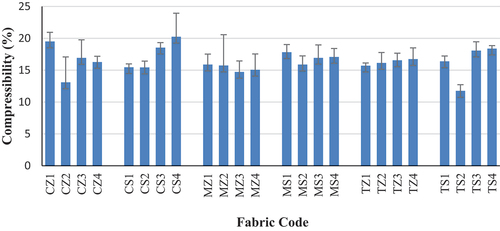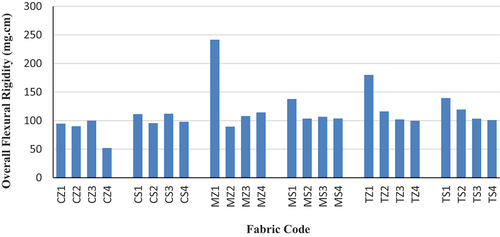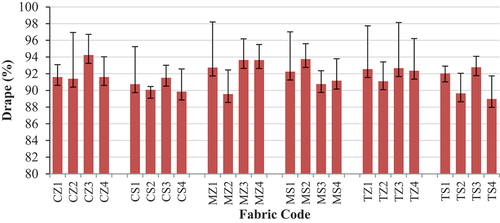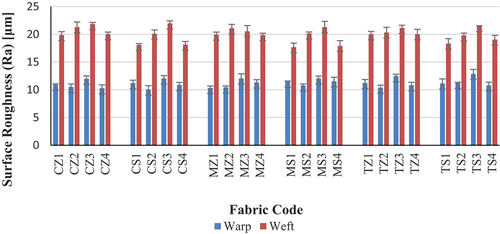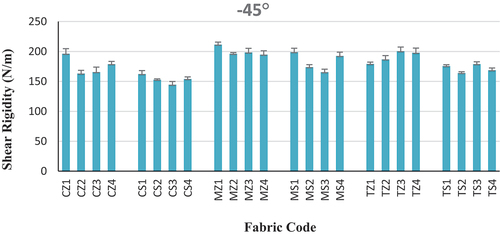 ?Mathematical formulae have been encoded as MathML and are displayed in this HTML version using MathJax in order to improve their display. Uncheck the box to turn MathJax off. This feature requires Javascript. Click on a formula to zoom.
?Mathematical formulae have been encoded as MathML and are displayed in this HTML version using MathJax in order to improve their display. Uncheck the box to turn MathJax off. This feature requires Javascript. Click on a formula to zoom.ABSTRACT
Denim fabrics are products that provide durability and ease of use, and are used by young people or people of all ages who prefer comfortable wear in daily life. In this study, the objective hand values of denim fabrics with three weft yarn types (100% cotton elastane, 85% cotton 15% Modal elastane, and 85% cotton 15% Tencel elastane), two twill directions (3/1 Z and S), and four washing processes (bleach, enzyme, rinse, and stone) were investigated. For this purpose, the compressibility, overall flexural rigidity, drape, surface roughness, and shear rigidity values of industrial washed denim fabrics were measured. It was found that there was no statistically significant effect of weft yarn type on objective hand values, and washing differences were statistically significant on the objective hand values of the denim fabrics. The results showed that enzyme-washed fabrics show better hand and lower hardness properties; stone-washed fabrics have a higher fluffy feel, bleach-washed fabrics have worse hand, and rinse-washed fabrics have stiffer and rougher surfaces. It was also observed that the twill direction affects only the shear rigidity values of the denim fabrics.
摘要
牛仔面料是一种具有耐用性和易用性的产品,供年轻人或在日常生活中喜欢舒适穿着的所有年龄段的人使用. 在本研究中,研究了三种纬纱类型(100%棉弹性纤维、85%棉15%莫代尔弹性纤维和85%棉15%天丝弹性纤维)、两种斜纹方向(3/1 Z和S)和四种洗涤工艺(漂白、酶、漂洗和磨石)的牛仔布织物的客观手值. 为此,测量了工业洗涤牛仔布的压缩性、整体弯曲刚度、悬垂性、表面粗糙度和剪切刚度. 研究发现,纬纱类型对牛仔布的客观手值没有统计学显著影响,洗涤差异对牛仔织物的客观手数值有统计学显著影响. 结果表明,酶洗织物具有较好的手感和较低的硬度; 石头洗的织物有更高的蓬松感,漂白过的织物手感更差,漂洗过的织品表面更硬、更粗糙. 还观察到斜纹方向只影响牛仔布织物的剪切刚度值.
Introduction
Denim trousers are especially preferred in daily wear because of their easy washing properties and durability. Denim is manufactured with 3/1 and 2/1 twill weave structures that weigh 14.5 ounces per square yard (Muthu Citation2017). Nowadays, new-generation fibers have begun to be used in denim fabric structures, apart from cotton and cotton/polyester yarns. Tencel, a new-generation fiber, can be used as an alternative to cotton fiber because of its silky hand and unique draping properties. In addition, the use of modal fiber has been increasing in recent years in fabrics because of its silky appearance, durability, comfort in clothing, high absorbency, and ease of care (Özbağcı Citation2008). Denim fabrics are subjected to processes such as dyeing, finishing, and coating to satisfy people’s expectations of fashion. Because denim fabrics have a very tight and hard structure after weaving, different washing processes should be performed, and the surface properties should be changed in terms of aesthetics and comfort. Tactile comfort is a feeling that results from the touch of fabric on the skin and is expressed in terms of softness, smoothness, wetness, and itching (Okur Citation2022). Tactile comfort is affected by many factors, from fiber to yarn, from yarn to fabric production, and to the finishing processes applied to the fabric (Özkan and Mazarı Citation2022). Therefore, the structure of the fabric surface had a significant effect on the sensations experienced. The tactile properties of textile materials include flexibility, compressibility, fabric texture, extensibility, and friction (Özçelik et al. Citation2008). The objective hand value is defined as a feeling that occurs when the fabric is in contact with the body surface, especially the hand value evaluated with the fingers and thumb (Bishop Citation1996). The KES-FB measurement system, one of the objective measurement methods developed by Kawabata and Niwan, was used to estimate human tactile sensations using mechanical measurements of fabrics (Kim, Yoo, and Kim Citation2005). Kawabata KES-FB4 system was used for the measurements of geometrical surface roughness (SMD) and coefficient of friction (MIU) values of fabrics (Lam et al. Citation2011). Several studies have reported on KES-F measurement systems. One study examined the correlation between friction and the objective hand of fabrics and found that the results of the KES-F device and the new device (TFA) were compatible (Bertaux, Lewandowski, and Derler Citation2007). Eryuruk (Citation2019) investigated the handle properties of different finishing-processed denim fabrics using the Kawabata Evaluation system and observed that elastane containing fabrics have lower surface roughness values. A new equipment (FTT) was used to evaluate sensory comfort, such as bending, compression, and surface properties. The Fabric Touch Tester can be used to discriminate between different properties of denim fabrics (Akgül, Kizilkaya Aydoğan, and Sinanoğlu Citation2022). In another study, the drape coefficients of fabrics were tested using a CCD camera connected to a Cusick drape meter. A good correlation was found between digital image analysis and classical methods (Behera and Pattanayak Citation2008). In some studies on denim fabrics, the effects of different washes on denim fabric properties were investigated. One of them the effect of cellulase on the low-stress mechanical properties of cotton denim was investigated, and it was found that cellulose resulted in higher flexibility, better elastic recovery, higher shearing stiffness, and improved smoothness (Yang et al. Citation2013). Uren and Okur (Citation2019) investigated denim fabrics in terms of their low-tensile mechanical features and sensory test results and stated that stone washing was the most efficient way to improve tactile comfort. In another study, the impact of industrial finishing and washing operations on some features of stretch denim fabrics was investigated, and it was observed that both the finishing and washing processes influence the fabric properties (Piroi, Harpa, and Oprea Citation2018). Repon et al. (Citation2021) investigated the effect of the industrial washing process on the density, shrinkage, tear strength and tensile strength of spandex containing denim fabrics and observed different washings changed test results significantly. In another study, the effect of extensibility on the mechanical properties of cotton blended polyester-spandex core-spun yarn 3/1 Z twill denim fabrics was investigated. It was observed that samples with higher cotton content had lower tensile and tearing strengths (Akter et al. Citation2021). The effects of the structure and rinse washing processes on some properties of woven fabrics were compared, and it was found that flax and hemp fibers provide similar hand results with cotton (Okur Citation2021). Abid et al. (Citation2022) investigated the impact of different industrial washing operations on the handling features of denim fabrics. It was observed that the shear stiffness value decreased with washings and the bending value improved.
It was found that there are a limited number of studies on the objective hand values of denim fabrics in the literature. The aim of this study was to investigate the effects of weft yarn types, twill weave direction, and washing types on objective hand values of denim fabrics. For this purpose, compressibility, bending rigidity, drape, surface roughness, and shear rigidity values of the denim fabrics were measured. In addition, the effect of using new-generation Tencel and Modal fibers in the denim fabric structure on the objective hand values was examined.
Material and methods
In the study, the warp thread was kept the same, and three types of weft yarns, namely 100% cotton elastane, 85% cotton 15% Modal elastane, and 85% cotton 15% Tencel elastane and two twill weave directions (S and Z) were used for the production of 3/1 Twill weaved denim fabrics (). Denim fabrics were treated using different washing methods, such as bleach, enzyme, rinse, and stone washing, to improve fabric quality and comfort. James Heal brand thickness (ASTM D1777) measuring device was used for fabric compressibility measurements. The fabrics were compressed under pressures of 5gf/cm2 and 50gf/cm2, and the compressibility ratios were calculated as % by finding the difference between fabric thicknesses (Üren and Okur Citation2019). The roughness measurements of the samples were performed on an Accretech Surfcom 130A instrument using the ISO 4287–1997 (Citation2005) standard. An SDL-Atlas fabric drape tester was used to evaluate the drape coefficient, according to the BS 5058 (Citation1973) standard. The bending rigidity of the fabrics was measured according to ASTM 1388–64 and TS 1409 (Citation1973) with a James Heal brand Shirley Stiffness Tester. The equations were used for the calculation of the overall flexural rigidity:
Table 1. Properties of fabrics and applied washing operations.
c = Bending length, O= The length of overhang in cm, G = Flexural rigidity in mg.cm, W = Weight per unit area in mg/cm2, Go = Overall flexural rigidity, Gw = Warp flexural rigidity, and Gf = Weft flexural rigidity (Gürarda and Çeven Citation2017).
The shear deformation of the fabric sample using the Bias extension method is shown in . The shear rigidity values of the fabrics were measured using the Bias extension method on a Shimadzu Strength Gauge device (). The shear deformation of the fabrics in the first situation and after deformation are shown in . Three different regions were formed by the shear deformation of the fabric (I-II-III). The full shear deformation was observed in the third region (III). In many studies, the deformation in zones I and II are neglected, and the height (L´) of section III is equal to the diagonal length (l-w) of the pure shear zone (Launay et al. Citation2008). In the test performed to determine the bending rigidity, rectangular samples were cut using a test length of 250 mm x 50 mm. For the test, the distance between the clamps (l) was 150 mm, w was the sample width, and L was the sample length. For the fabric tests, five samples were cut in the +45° and −45° directions and their measurement results were recorded. The shear angle (γbe) for the bias extension method was evaluated using EquationEquation (4)(4)
(4) , where d is the shear displacement (Uren, Oner, and Okur Citation2017). In this study, the shear angle was kept constant (12°) and the displacement amount was determined using EquationEquation (4)
(4)
(4) . The displacement amount was entered into the test device as a constant, and the applied load (N) was measured in both directions. The shear rigidity was evaluated by substituting into EquationEquation (5)
(5)
(5) , where F is the shear force, and w is the fabric width perpendicular to the applied load.
Figure 1. a) Shear deformation of the fabric sample at Bias extention method b) Bias extension method shear force test in Shimadzu Strength Gauge device c) Shear deformation: (1) first situation; (2) after deformation (Dolatabadi, Kovař, and Linka Citation2009; Uren, Oner, and Okur Citation2017).
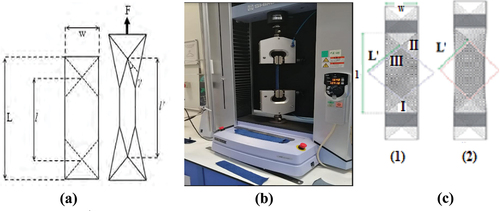
The effect of the factors was investigated by performing a Multivariate test using the SPSS 28 statistical package program. The Student-Newman-Keuls (SNK) test was performed to analyze the differences between the groups at a level of p ˂ 0.05 confidence interval.
Results and discussions
Compressibility of Denim fabrics
The compressibility value is one of the most important features that affect the handling properties of fabrics, such as fullness, softness, bulkiness, and resilience (Kawabata, Niwa, and Kawai Citation1978). The compressibility properties of fabrics are proportional to their thickness, and this feature provides a feeling of sponginess and bulkiness in the fabric. The compressibility values of the fabrics are shown in . The highest compressibility value was observed in the cotton elastane S-twill stone-washed fabric (CS4), which represents the highly fluffy feeling of this fabric from the others. The lowest compressibility value was observed in the cotton/Tencel elastane S-twill enzyme-washed fabric (TS2). The SNK test of the compressibility results is presented in . It was observed that the weft yarn type did not cause a statistically significant difference in the compressibility values of the denim fabrics. It was also found that the use of Modal and Tencel yarns with cotton in the denim structure reduces compressibility values. Although it was stated that the use of cellulase enzyme increased the compressibility feature in previous studies (Yang et al. Citation2013), the lowest compressibility values were measured in enzyme-washed fabrics in this study. The highest compressibility values were observed in the stone-washed samples, which means that these fabrics felt softer than the other washings. Denim fabrics are normally solid fabrics after weaving, and stone washing had a greater effect on the surface of the fabric than especially enzyme washing because pumice stones were used together with the enzyme in stone washing.
Table 2. SNK test for compressibility and bending length values of samples.
Overall flexural rigidity values of fabrics
The overall flexural rigidity (bending rigidity) of a fabric depends on the structure of the yarns that make up the fabric, the fiber structure, the fabric weave, and the applied finishing processes. In addition, fabric samples with high bending rigidity are difficult to sew, and many difficulties such as needle breakage may be encountered during sewing. It has been stated that the bending feature affects the properties such as attitude, draping, clothing appearance, and fit in previous studies (Lee et al. Citation2015). The overall flexural rigidity values of the fabrics are shown in . The highest overall flexural rigidity value was observed for cotton/Modal elastane Z-twill fabric with bleach washing (MZ1), leading to a stiffer feeling. The lowest overall flexural rigidity value was observed in the stone-washed 100% cotton elastane fabric with Z-twill (CZ4), leading to a softer feeling. It was observed that the overall flexural rigidity values of the S- and Z-twill fabrics were close to each other. Thus, it was concluded that the overall flexural rigidity value did not change with the fabric aspect but changed with the applied washing process. The rinse-washed and stone-washed denim fabrics exhibited the lowest overall flexural rigidity values. On the other hand, bleach-washed denim fabrics exhibited the highest overall flexural rigidity values.
The overall flexural rigidity value was calculated using EquationEquation (3)(3)
(3) after the bending lengths in the warp and weft directions were found. The SNK test results for the bending lengths are given in . It was observed that the bleach-washed fabrics were statistically different from the others, and the highest bending length values were measured in this washing. Although stone-washed fabrics showed similar results with rinse and enzyme-washed fabrics, the lowest bending length values were observed for these fabrics. This supports the idea that stone washing increased the rubbing action between the fabric and pumice stone, which decreased the bending length and increased its softness (Sarkar and Khalil Citation2014). It was stated that the bending value is inversely proportional to the fabric handle value and the fabric handle value decreases as the bending rigidity increases (Kumar et al. Citation2021). The overall flexural rigidity value increases as the bending length increases. It can be said that fabrics with a higher overall flexural rigidity value show stiffer handling and more difficult sewing properties. Therefore, it can be concluded that stone-washed fabrics have a softer handle and easy sewability.
Drape of fabrics
Drape is described as a measure of the deformation of a suspended fabric under the influence of its own weight (BSI Citation1974). While draping affects the approval of a textile product by the consumer, it also plays an effective role in the design, production, reproduction, and adjustment of the garment to the human silhouette. It also affects the fit, mobility, and comfort of garments (Fan, Yu, and Hunter Citation2004; Mah and Song Citation2010). The drape values of the fabrics are shown in . It was observed that the draping values of the fabrics varied between 88% and 95%. The highest drape value was measured for the 100% cotton Z-twill rinse-washed fabric. Because the drape value of the fabrics is between 0–100 and the value of 100 indicates the highest stiffness, the softest fabric was cotton/Tencel elastane S-twill woven stone-washed fabric (TS4) containing Tencel fiber. This supports a previous study in which the Tencel percentage increment in any cotton-based denim increased the fabric drapability (Islam et al. Citation2022). When the effect of washing type was investigated, it was observed that the highest drape value was obtained in the rinse-washed fabrics, and the lowest drape value was observed in the enzyme-washed fabrics. This means that the rinse-washed fabrics measured hardest than the other washings. Because the stiffness of the fabric increases as the drape value increases, the cotton/modal elastane weft yarn included fabrics were measured as stiffest than 100% cotton elastane, and cotton/Tencel elastane included fabrics in general.
Surface roughness of fabrics
The surface roughness of textile structures is an important property that affects the fabric handle. Yarn properties, fabric construction, and performed finishing operations are parameters that affect the fabric surface properties (Viswanath and Ramachandran Citation2010). It was stated that the surface roughness features of fabrics are important because they affect the quality and tactile properties of the fabric (Akgun Citation2015). Ra is defined as the arithmetic mean of the absolute values of the profile deviations (peaks and valleys) from the mean line over the evaluation length and is the most important factor used to analyze the surface structure (Gadelmawla et al. Citation2002). The surface roughness values of the fabrics are shown in . The results showed that the surface roughness value in the weft direction was higher than that in the warp direction for all fabrics because different cotton blended yarns were used in the weft direction. The surface roughness values of the rinse-washed fabrics in the weft and warp directions were higher than those of the other washings (except for MZ3 coded fabric). The SNK test for the surface roughness values of fabrics is presented in . The statistical analysis results showed that the weft yarn type did not have a significant difference in the surface roughness value, and the highest surface roughness value was observed when the cotton/Tencel elastane weft yarn was used. As stated in previous studies, Tencel fibers have a peach skin effect. Although it improves the handle properties, it causes roughness on the surface (Badr et al. Citation2014). Considering the effect of washing on the surface roughness value, it was observed that rinse washing gave statistically significant results compared with the other washing types. It can be said that rinse washing may cause discomfort in the wear situation by increasing surface roughness.
Table 3. SNK test for shear rigidity and surface roughness values of samples.
Shear rigidity values of fabrics
The bias extension method, which is one of the conventional methods, was used for measurements. Within the scope of this study, the forces causing the formation of the shear angle were determined by keeping the displacement amount constant, and the shear force values in the +45° and −45° directions were measured. The shear rigidity of a fabric depends on the mobility of the cross threads at the intersection, and this mobility is affected by the weave, yarn diameter, and surface properties of the yarn and fabric (Kumari and Khurana Citation2016). The shear rigidity values of the denim fabrics were found in the +45° and −45° directions by substituting the shear force values in EquationEquation (5)(5)
(5) . The shear rigidity values of the +45° direction samples are shown in . The shear rigidity values of the cotton/Modal elastane weft yarn S-twill woven fabrics were higher than those of the other fabrics. The lowest shear rigidity values were observed in the 100% cotton elastane Z-twill woven fabrics. Considering the effect of washing type, it was observed that the shear rigidity values of the 100% cotton elastane and cotton/Modal elastane weft yarn fabrics were measured as the lowest in the case of enzyme washing. When the effect of the fabric weave direction on the shear rigidity value was examined, it was observed that the S-twill fabrics had higher shear rigidity values in the +45° sample direction.
The shear rigidity values of −45° direction samples are shown in . When the shear rigidity values of the 100% cotton elastane and cotton/Modal elastane weft yarn included fabrics were compared, the highest shear rigidity values were measured for bleach washing. Among these fabrics, the lowest shear rigidity value was measured in the case of enzyme washing in the Z-twill and rinse washing in the S-twill. When the effect of the fabric weave direction on the shear rigidity value was examined, it was observed that the shear rigidity value of the Z-twill fabrics was higher in the −45° sample direction. It can be concluded that the shear rigidity values were higher when the sample and twill weave directions were opposite to each other.
The SNK test of shear rigidity test results is presented in . The results indicated a statistically significant difference between the tested fabrics. In addition, blending cotton with Modal and Tencel increased the shear rigidity values of the fabrics. This can be explained by the higher crystallization degree of the Tencel and Modal fibers than that of the cotton fiber. Considering the effect of washing on shear rigidity value, the highest shear rigidity values were measured in the case of bleach washing, and the lowest shear rigidity values were measured in the case of enzyme washing. The lower the shear rigidity, the higher the fabric handle. Thus, the best handle properties were measured in the case of enzyme washing.
Conclusion
In this study, the effects of using 100% cotton elastane, 85% cotton 15% Tencel elastane, and 85% cotton 15% Modal elastane yarns in the weft direction, two different twill directions, and the effects of different washing operations on the objective hand properties of denim fabrics were investigated. It was observed that the use of cotton blended Tencel and Modal yarns in the weft direction did not have a statistically significant effect, but it reduced the compressibility values, increased the shear rigidity value, and increased the bending length. On the other hand, it can be said that the use of Tencel increases sewability by decreasing the drape value, and the use of modal creates a smoother surface by reducing surface roughness. In this study, it was observed that the parameter that affected the objective hand value was washing type. The results showed that enzyme-washed fabrics have better hand and lower hardness properties, bleach-washed fabrics have worse hand and sewability, rinse-washed fabrics have stiffer and rougher surfaces, and stone-washed fabrics have softer hand and easy sewability. Also, the shear rigidity value was measured higher when the sample direction and twill weave direction were opposite to each other. Since the amount of Modal and Tencel fibers in the weft yarn composition was kept low in this study, a statistically significant effect of these fibers was not observed on objective hand value. It is recommended to keep the fiber ratio high to observe the effect of these fibers more clearly in future studies.
Highlights
New generation fibers with known comfort properties such as Tencel and Modal have been used in the denim fabric structure,
It was found, there was no statistically significant effect of weft yarn differences on the objective hand values of denim fabrics.
It was seen that the parameter that affects the objective hand value was the washing type.
The twill direction has an effect on shear rigidity values.
It can be said that the use of Tencel increases sewability by decreasing the drape value,
The use of Modal creates a smoother surface by reducing the surface roughness.
Stone washing fabrics have a softer hand and easy sewability
Acknowledgements
This work was supported by the TÜBİTAK 1505 - University-Industry Cooperation Support Program with the ISKUR Denim Kahramanmaraş and Bursa Uludag University partnership (Project number 5210060).
Disclosure statement
No potential conflict of interest was reported by the authors.
Additional information
Funding
References
- Abid, H. A., A. Rehman, M. Ashraf, S. Q. Z. Gilani, and A. Javid. 2022. Kawabata analysis of cotton denim fabrics treated with industrial washing techniques. Journal of Natural Fibers 19 (16):14813–12. doi:10.1080/15440478.2022.2069187.
- Akgül, E., E. Kizilkaya Aydoğan, and C. Sinanoğlu. 2022. Investigation of different denim fabrics with fabric touch tester and sensory evaluation. Journal of Natural Fibers 19 (13):5551–65. doi:10.1080/15440478.2021.1881687.
- Akgun, M. 2015. Assessment of the effect of fabric constructional parameters on surface roughness of wool fabrics. The Journal of the Textile Institute 106 (8):845–52. doi:10.1080/00405000.2014.948730.
- Akter, N., M. R. Repon, D. Mikučionienė, M. A. Jalil, T. Islam, and M. R. Karim. 2021. Fabrication and characterization of stretchable denim fabric using core spun yarn. Heliyon 7 (12):1–12. doi:10.1016/j.heliyon.2021.e08532.
- Badr, A. A., A. El-Nahrawy, A. Hassanin, and M. S. Morsy. 2014. “Comfort and protection properties of tencel/cotton blends.” Beltwide Cotton Conferences, New Orleans, January 6-8.
- Behera, B. K., and A. K. Pattanayak. 2008. Measurement and modelling of drape using digital image processing. Indian Journal of Fibre and Textile Research 33 (3):230–38.
- Bertaux, E., M. Lewandowski, and S. Derler. 2007. Relationship between friction and tactile properties for woven and knitted fabrics. Textile Research Journal 77 (6):387–96. doi:10.1177/0040517507074165.
- Bishop, D. P. 1996. Fabric: Sensory and mechanical properties, the textile institute, textile progress, UK. Textile Progress. 26 (3):1–62. ISBN= 1870812751. doi:10.1080/00405169608688866.
- BS 5058. 1973, October 12. Method for the assessment of drape of fabrics, Standard. BSI Group.
- BSI (British Standards Institution). 1974. The assessment of drape of fabrics, BS Handbook 11: British standards institution, 4, 29–31.
- Dolatabadi, M. K., R. Kovař, and A. Linka. 2009. Geometry of plain weave fabric under shear deformation. Part I: Measurement of exterior positions of yarns. The Journal of the Textile Institute 100 (4):368–80. doi:10.1080/00405000701830474.
- Eryuruk, S. H. 2019. The effects of elastane and finishing processes on the performance properties of denim fabrics. International Journal of Clothing Science and Technology 31 (2):243–58. doi:10.1108/IJCST-01-2018-0009.
- Fan, J., W. Yu, and L. Hunter. 2004. Clothing appearance and fit: Science and technology. England: Woodhead Publishing.
- Gadelmawla, E. S., M. M. Koura, T. M. A. Maksoud, I. M. Elewa, and H. H. Soliman. 2002. Roughness parameters. Journal of Materials Processing Technology 123:133–45. doi:10.1016/S0924-0136(02)00060-2.
- Gürarda, A., and E. K. Çeven. 2017. Influence of women’s dress woven fabric structure on bending and drapability properties. Uludağ University Journal of the Faculty of Engineering 22 (1):179–88. doi:10.17482/uumfd.309475.
- Islam, I., N. H. Khan, A. Islam, M. A. Rahaman, and M. Islam. 2022. Investigate the fabric performance of Tencel-cotton blended denim in terms of the percentage change of Tencel. Tekstilna industrija 70 (3):58–66. doi:10.5937/tekstind2203058I.
- ISO 4287-1997 (International Organization for Standardization). 2005. Geometrical product specification (GPS) - Surface texture: Profile method – terms, definitions and surface texture parameters. Geneva.
- Kawabata, S., M. Niwa, and Y. Kawai. 1978. Study on the compressional deformation of woven fabrics part 1: Measurement of the compressional property of yarns. Sen’i Kikai Gakkaishi (Journal of the Textile Machinery Society of Japan) 31 (5):74. doi:10.4188/transjtmsj.31.5_T74.
- Kim, D. O., S. Yoo, and E. A. Kim. 2005. Objective measures for perceived touch of worsted fabrics. International Journal of Industrial Ergonomics 35:1159–69. doi:10.1016/j.ergon.2005.05.002.
- Kumari, A., and K. Khurana. 2016. Regenerated cellulose-based denim fabric for tropical regions: An analytical study on making denim comfortable. Journal of Textiles 2016:1–10. doi:10.1155/2016/4614168.
- Kumar, M., S. R. Shukla, A. Arputharaj, S. Saxena, S. Patil, P. G. Patil, E. Varghese, and R. Amarowicz. 2021. Biopolishing of cellulosic fabrics: A study on low-stress mechanical properties, microstructure, and dye uptake. Fibers and Polymers 22 (10):2803–14. doi:10.1007/s12221-021-0356-8.
- Lam, Y. L., C. W. Kan, C. W. M. Yuen, and C. H. Au. 2011. Objective measurement of fabric properties of the plasma-treated cotton fabrics subjected to cocatalyzed wrinkle-resistant finishing. Journal of Applied Polymer Science 119 (5):2875–84. doi:10.1002/app.32965.
- Launay, J., G. Hivet, A. V. Duong, and P. Boisse. 2008. Experimental analysis of the influence of tensions on in plane shear behaviour of woven composite reinforcements. Composites Science and Technology 68 (2):506–15. doi:10.1016/j.compscitech.2007.06.021.
- Lee, I. Y., G. E. Jeong, S. R. Kim, C. Bengelsdorff, and S. D. Kim. 2015. Effects of biowashing and liquid ammonia treatment on the physical characteristics and hand of denim fabric. Coloration Technology 131 (3):192–99. doi:10.1111/cote.12142.
- Mah, T., and G. Song. 2010. An investigation of the assessment of fabric drape using three-dimensional body scanning. The Journal of the Textile Institute 101 (4):324–35. doi:10.1080/00405000802417122.
- Muthu, S. 2017. Sustaınabılıty ın denım. USA: Woodhead Publıshıng.
- Okur, N. 2022. Thermo-physiological and handle-related comfort properties of hemp and flax blended denim fabrics. Journal of Natural Fibers 19 (15):10179–92. doi:10.1080/15440478.2021.1993488.
- Okur, N. 2022. ''Thermo-physiological and handle-related comfort properties of hemp and flax blended denim fabrics.''. Journal of Natural Fibres 19 (15):10179–92.
- Özbağcı, Ö. 2008. Physical and dimensional properties of single jersey fabrics produced from 100 % cotton and some regenerated cellulosic fibres. Master diss., Dokuz Eylül University.
- Özçelik, G., G. Süpüren, T. Gülümser, and I. Tarakçıoğlu. 2008. A study on subjective and objective evaluation of the handle properties of shirt fabrics. Fibres & Textiles in Eastern Europe 16 (3):56–62.
- Piroi, C., R. Harpa, and M. Oprea. 2018. “Regarding the effect of finishing processes on some properties of stretch denim fabrics.” Aegean International Textile and Advanced Engineering Conference (AITAE 2018), Greece, September 5-7. doi: 10.1088/1757-899X/459/1/012059.
- Repon, M. R., H. T. Sadia, M. R. Karim, M. U. Munir, and M. A. Jalil. 2021. Stretchable denim properties dependency on industrial washing techniques. Fibers and Textiles 28 (2):75–81.
- Sarkar, J., and E. Khalil. 2014. Effect of industrial bleach wash and softening on the physical, mechanical and color properties of denim garments. IOSR Journal of Polymer and Textile Engineering 1 (3):46–49. doi:10.9790/019X-0134649.
- Taştan Özkan, E., and F. B. Mazari. 2022. Investigating thermal comfort and surface properties of 3/1 Z twill weaved denim fabrics. Adıyaman University Engineering Sciences Journal 9 (18):548–61. doi:10.54365/adyumbd.1133604.
- TS 1409 (Turkish Standard). 1973. Stiffness determination of woven textiles.
- Uren, N., and A. Okur. 2019. Analysis and improvement of tactile comfort and low-stress mechanical properties of denim fabrics. Textile Research Journal 89 (23–24):4842–57. doi:10.1177/0040517519840634.
- Üren, N., and A. Okur. 2019. “Surface profile and frictional properties of denim fabrics.” AUTEX2019 – 19th World Textile Conference on Textiles at the Crossroads, Ghent, Belgıum, 11–15 June.
- Uren, N., E. Oner, and A. Okur. 2017. A novel approach for precise determination of in-plane shear behavior of woven fabrics. Textile Research Journal 87 (11):1335–48. doi:10.1177/0040517516652346.
- Viswanath, C. S., and T. Ramachandran. 2010. Comfort characteristics of cotton fabrics finished with fluoro-alkyl nano lotus finish. Indian Journal of Fibre & Textile Research 35:342–48.
- Yang, R. H., C. W. Kan, W. Y. Wong, and M. C. Law. 2013. Comparative study of cellulase treatment on low stress mechanical properties of cotton denim fabric made by torque-free ring spun yarn. Fibers and Polymers 14 (4):669–75. doi:10.1007/s12221-013-0669-3.

